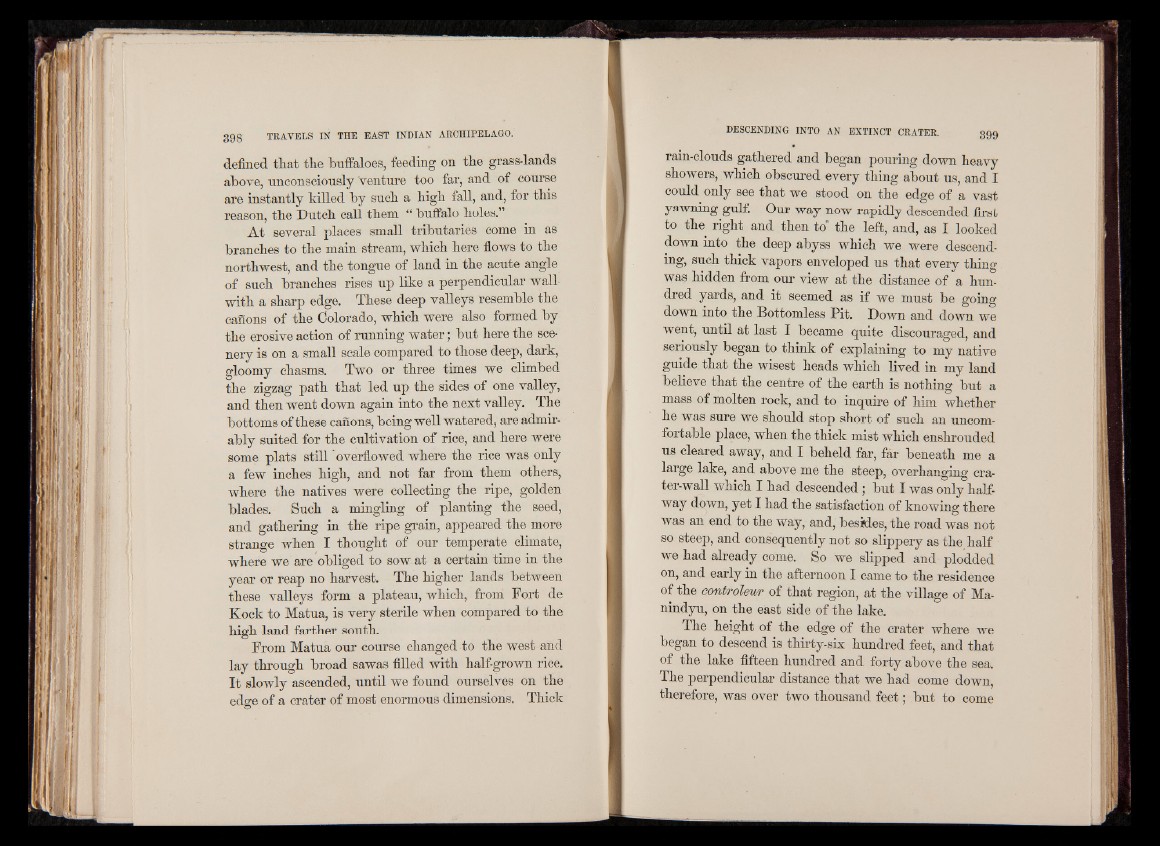
defined that the hnffaloes, feeding on the grass-lands
above, unconsciously venture too far, and of course
are instantly killed by such a high fall, and, for this
reason, the Dutch call them “ buffalo holes.”
At several places small tributaries come in as
branches to the main stream, which here flows to the
northwest, and the tongue of land in the acute angle
of such branches rises up like a perpendicular wall
with a sharp edge. These deep valleys resemble the
canons of the Colorado, which were also formed by
the erosive action of running water; but here the scenery
is on a small scale compared to those deep, dark,
gloomy chasms. Two or three times we climbed
the zigzag path that led up the sides of one valley,
and then went down again into the next valley. The
bottoms of these canons, being well watered, are admirably
suited for the cultivation of rice, and here were
some plats still overflowed where the rice was only
a few inches high, and not far from them others,
where the natives were collecting the ripe, golden
blades. Such a mingling of planting the seed,
and gathering in the ripe grain, appeared the more
strange when I thought of our temperate climate,
where we are obliged to sow at a certain time in the
year or reap no harvest. The higher lands between
these valleys form a plateau, which, from Fort de
Kock to Matua, is very sterile when compared to the
hip-li o land farther south.
From Matua our course changed to the west and
lay through broad sawas filled with half-grown rice.
It slowly ascended, until we found ourselves on the
edge of a crater of most enormous dimensions. Thick
DESCENDING INTO AN EXTINCT CRATER. 3 9 9
*
rain-clouds gathered and began pouring down heavy
showers, which obscured every thing about us, and I
could only see that we stood on the edge of a vast
yawning gulf. Our way now rapidly descended first
to the right and then to' the left, and, as I looked
down into the deep abyss which we were descending,
such thick vapors enveloped us that every thing
was hidden from our view at the distance of a hundred
yards, and it seemed as if we must be going
down into the Bottomless Pit. Down and down we
went, until at last I became quite discouraged, and
seriously began to think of explaining to my native
guide that the wisest heads which lived in my land
believe that the centre of the earth is nothing but a
mass of molten rock, and to inquire of him whether
he was sure we should stop short of such an uncomfortable
place, when the thick mist which enshrouded
us cleared away, and I beheld far, far beneath me a
large lake, and above me the steep, overhanging era
ter-wall which I had descended; but I was only halfway
down, yet I had the satisfaction of knowing there
was an end to the way, and, besides, the road was not
so steep, and consequently not so slippery as the half
we had already come. So we slipped and plodded
on, and early in the afternoon I came to the residence
of the conftroleu/r of that region, at the village of Ma-
nindyu, on the east side of the lake.
The height of the edge of the crater where we
began to descend is thirty-six hundred feet, and that
of the lake fifteen hundred and forty above the sea.
The perpendicular distance that we had come down,
therefore, was over two thousand feet; but to come